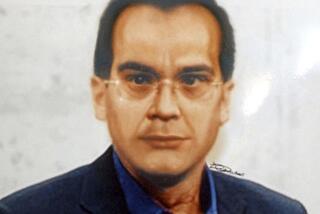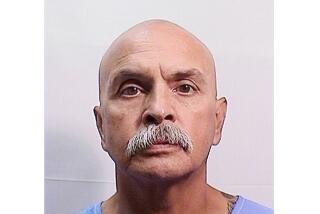Judge rules in favor of trafficker
He served 22 years behind bars on a conviction for heroin trafficking. The U.S. wanted to deport him -- and Italy wanted him back.
But there was a problem: His name was Rosario Gambino, with alleged ties to the infamous Gambino crime family.
If removed to his native country, a Los Angeles-area immigration judge ruled, Gambino likely would be arrested and locked up in a prison system designed to physically and psychologically compel criminals like him to reveal information about the Sicilian Mafia.
âThis . . . coercion is not related to any lawfully imposed sanction or punishment, and thus constitutes torture,â Judge D.D. Sitgraves wrote in his opinion, issued Sept. 11.
Gambino could stay in the country, the judge decided.
P. Joseph Sandoval, Gambinoâs attorney, said the judgeâs ruling, based on the United Nations Convention Against Torture, was â100% correct.â
âItâs a humanitarian issue,â Sandoval said. âThe prison conditions in his specific case will be life-threatening and life-shortening.â
This month, Sandoval filed a petition in federal court to have his client released from an immigration detention center in San Pedro, where he has been held for the last year, after his release from federal prison.
âIf it wasnât because of my name,â Gambino said through his attorney, âI would already be out.â
But Gambino, according to some immigration attorneys, has already proved more fortunate than most.
Such relief, citing the threat of torture, is granted infrequently, according to the Executive Office of Immigration Review, which oversees the immigration courts. Last year, judges nationwide approved 578 petitions and denied 15,905.
Immigration attorneys say the outcome of such cases can be arbitrary, depending on the judge, the attorneys and the personâs native country.
In recent years, attorneys increasingly have pushed to get relief for foreign-born gang members facing deportation but are rarely successful.
âIt does make you wonder why arenât more Convention Against Torture cases being granted for people from Central America, given the countriesâ conditions and how poorly suspected gang members are treated by the government,â said Alan Diamante, a Los Angeles immigration attorney
Diamante had two such cases recently. A Honduran former gangster who previously had been deported and had a criminal record won his case. But an 18th Street gang member with drug-related convictions lost, despite testimony that he would face grave danger if deported. Within weeks of returning to El Salvador, he was killed.
But Gambino himself is not in the clear.
The Immigration and Customs Enforcement agency has filed an appeal of his case. The agency also plans to contest any attempt to have Gambino released from custody, said spokeswoman Virginia Kice.
âHe is detained because we believe he poses a potential threat to the community,â Kice said. âFirst, he was convicted of heroin trafficking and second, he has ties to a notorious and ruthless crime family.â
Gambino denies any connection to organized crime, though he has been referred to in court documents from his 1984 criminal trial as a âsoldierâ of the Gambino crime family, and testimony from this yearâs immigration trial revealed that the Italian government considers him a member of the Sicilian Mafia.
Mafia expert Jerry Capeci said in an interview that Gambino -- cousin of the late mob boss Carlo Gambino -- is not a âmadeâ member in the United States and doesnât have much sway in the family because he has been in prison for more than 20 years.
âBut his two brothers are made members of the crime family, and there is no question that he has some influence in the family,â said Capeci, author of several books about the Mafia.
The Italian government attempted to extradite Gambino in 2001, based on an in absentia conviction for drug trafficking. The U.S. District Court in California denied the request because Gambino had already been acquitted on similar charges in New York. Gambino still has a pending Italian arrest warrant, Italian government officials said.
âWe are talking about a bad guy -- someone who is wanted by Italian officials,â said Luigi Rinella, an Italian national police liaison officer, in a telephone interview.
Rinella called Gambino âa member of a very important La Cosa Nostra family in New Yorkâ who took part in a major drug-trafficking operation between Italy and the United States in the 1980s.
Rinella said there was no guarantee that Gambino would be locked up in the special prison system, known as 41-bis. The prison system, which keeps Mafia members in isolation, was designed by the Italian government to ensure that people with links to organized crime could not give orders from behind bars, Rinella said.
The 41-bis prisons are harsh, he added, but inmates are not tortured. âWe donât have torture in Italy,â he said.
Sandoval said the issue was not whether Italy engages in torture, but whether inmates in the 41-bis prison system are subjected to âcruel, inhuman or degrading treatmentâ that has nothing to do with their punishment. Gambinoâs immigration trial took place in San Pedro in February and featured testimony from an expert in solitary confinement, a Nobel Peace Prize nominee and a former FBI agent.
âThe environment in 41-bis does produce an opportunity for some of the law enforcement agents . . . to engender psychological and physical coercion on the detainees in order to obtain from them cooperation in the official fight against organized crime,â said DePaul University law professor M. Cherif Bassiouni, who was nominated for a peace prize for his role in the creation of an International Criminal Court.
Bassiouni said he had no doubt that Gambino would be arrested in Italy and that âhis return would be heralded as a great triumph over organized crime.â
Several witnesses, including a former FBI agent hired by Gambino to assess his risk in Italy, testified that Gambino likely would be placed in the 41-bis regime and be coerced into revealing information about Mafia members in Italy and the U.S.
In addition, Gambino suffers from medical problems that would be exacerbated by the limited care and extensive time in solitary confinement, according to the testimony.
In her closing statement, government attorney Michelle Phillips-Myers wrote that the Italian government âactively opposesâ torture. If Gambino is sentenced to the 41-bis regime, she wrote, it should be considered a âlawful sanction with a legitimate purpose of protecting public safety and preventing criminal activity.â
--
(BEGIN TEXT OF INFOBOX)
Background
The Gambino crime family was a large and powerful organized crime group and one of New York Cityâs five long-standing Mafia families, along with the Genoveses, Luccheses, Bonannos and Colombos. Authorities believe the familyâs illegal activities, including extortion, money laundering and stock fraud, brought in hundreds of millions of dollars each year.
Since its inception, the Gambino family has had numerous bosses, including Carlo Gambino, Paul Castellano and John Gotti. After Gottiâs 1992 conviction for murder and racketeering, the familyâs influence and fortunes declined significantly.
One of Carlo Gambinoâs distant cousins was Rosario Gambino, part of the âCherry Hill Gambinosâ from Cherry Hill, N.J. One author referred to the Cherry Hill Gambinos as âthe pivot of the Sicilian Mafia operations in the United States.â Gambino and his two brothers ran pizzerias, and authorities believed all three were involved in narcotics trafficking from Italy to the United States.
Rosario Gambino was convicted in 1984 in New Jersey of heroin trafficking and sentenced to 45 years in federal prison. Italy tried unsuccessfully to extradite him on an in absentia conviction there.
Source: Times Staff Reports
More to Read
Sign up for Essential California
The most important California stories and recommendations in your inbox every morning.
You may occasionally receive promotional content from the Los Angeles Times.





![[20060326 (LA/A20) -- STATING THE CASE: Marchers organized by unions, religious organizations and immigrants rights groups carry signs and chant in downtown L.A. "People are really upset that all the work they do, everything that they give to this nation, is ignored," said Angelica Salas of the Coalition of Humane Immigrant Rights. -- PHOTOGRAPHER: Photographs by Gina Ferazzi The Los Angeles Times] *** [Ferazzi, Gina -- - 109170.ME.0325.rights.12.GMF- Gina Ferazzi/Los Angeles Times - Thousands of protesters march to city hall in downtown Los Angeles Saturday, March 25, 2006. They are protesting against House-passed HR 4437, an anti-immigration bill that opponents say will criminalize millions of immigrant families and anyone who comes into contact with them.]](https://ca-times.brightspotcdn.com/dims4/default/34f403d/2147483647/strip/true/crop/1983x1322+109+0/resize/840x560!/quality/75/?url=https%3A%2F%2Fcalifornia-times-brightspot.s3.amazonaws.com%2Fzbk%2Fdamlat_images%2FLA%2FLA_PHOTO_ARCHIVE%2FSDOCS%2854%29%2Fkx3lslnc.JPG)




